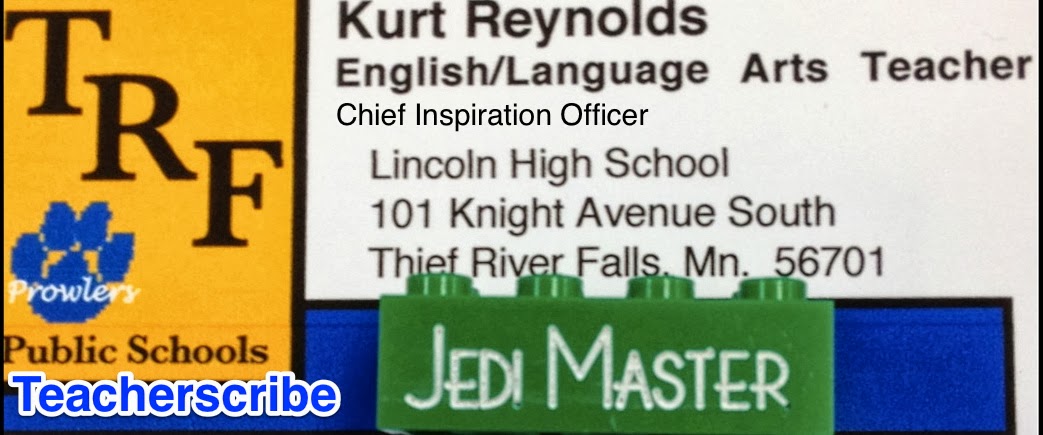Today was a winner. In Brit Lit we took a look at Oscar Wilde. I printed off a list of his infamous quotes (you can see on on the sidebar) and had students choose one to analyze. That will make for some interesting reading. Then we tackled chapter one of "Dorian Gray."
Next up was Comp II. I usually bang my head against a wall with these guys, but today they were raring to go. After a some quick routine work on adverb clauses, I introduced theme #8, the persuasive essay. Gulp, I teach this in the traditional five paragraph theme. Well, almost. It's got a thesis and three supporting paragraphs, but I've put my own twist into it. Instead of beginning with a generic intro, I give them some options - they can begin with an explanation of their topic, a narrative introducing us to their topic (this is the one I always push for), or creative a vivid example of their subject. Then, of course, they have to have their three pronged thesis in there. But here I introduce another twist. Their first two points have to be from their side of the argument. Then for their final supporting paragraph they have to take an opponent's viewpoint and reason it back against them. For example, if I'm arguing (as we did today) in class against country music, my two reasons against it would be that it's cliché and unoriginal. Then for my third point, I'd take a country music aficionados point, say that country music is popular and appeals to a very wide array of people, and reason it back against that claim (maybe stating that just because something is popular doesn't mean it should be blindly followed - that's how we got country music in the first place - along with tractor pulls, Nascar, line dancing, electric bull riding, and all other sorts of hick phenomena).
I began by introducing them to the Toulim Method of persuasion. He proposes that all successful arguments contain three things. First, one must have a claim (where the arguer states what they want). Second, one must base their claim on grounds (the proof the arguer must supply about their claim). Third, and most importantly, one must achieve a warrant (this is the interaction of the first two elements. The warrant is usually implied.)
Here is how it works in advertising. Pick up a magazine. You'll undoubtedly find cigarette ads. The claim of the tobacco company is 'buy our product.' Their warrants vary - 'they are cheap,' 'they are refreshing,' 'they are quality' . . . Now each advertisements usually has some young, hip people on it doing all sorts of athletic or fashionable things. That is the warrant - it implies to the viewer that if they buy the cigarettes not only will they be refreshing and of high quality, but they will make the smoker better looking, more popular, and quite fashionable. Now this is, of course, ridiculous. But it works. Just check out the tobacco sales despite the prices. The Joe Camel advertising campaigning by Camel cigarettes used the Toulim method to perfection to addict millions of kids to tobacco.
I ran into this type of argument two years ago when we took a trip to Dickenson, ND. We gave KoKo $20. She was told this was her spending money for the trip. We thought we'd teach her some responsibility. Inevitably, we entered the Dickenson Mall. KoKo spotted and Claire's and headed in. Kristie and her mom were off shopping somewhere and Casey was too, so I sat down and kept an eye on KoKo.
Eventually, I got the beckoning wave from KoKo. I tried to ignore her, but that only last a few minutes. Finally, I got up and trudged over the store. KoKo has about a dozen littler trinkets picked out that came to about $2.34. That wasn't the problem. The problem was that she wanted me to pay for it (her claim). I said no way. But she said she didn't want to break her $20 (her grounds). That was when they warrant hit me: in my mind I saw her trying to manage all of the change in her little purse. Then I saw her trying to fish out a quarter for a gumball machine and then having a five fall out. Then I saw her squandering more of her money. Before I knew it, I was plunking down the change and shuffling her out of there with her nice crisp $20 intact. She had perfectly manipulated me using the Toulim Method!
I had students come up with their own examples of using this - many knew perfectly well how to use it - to get the keys for the weekend, to get new vehicles, to get money, and so on and on.
And it's true. We are all expert manipulators. We were just getting around to debating topics when time ran out.
I love it when that happens.

No comments:
Post a Comment